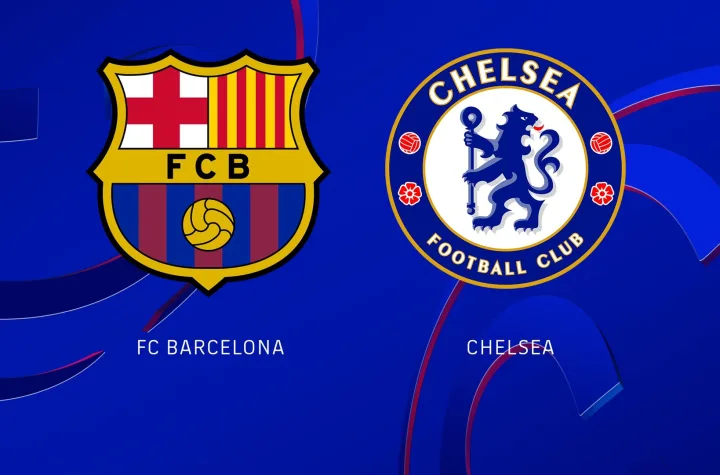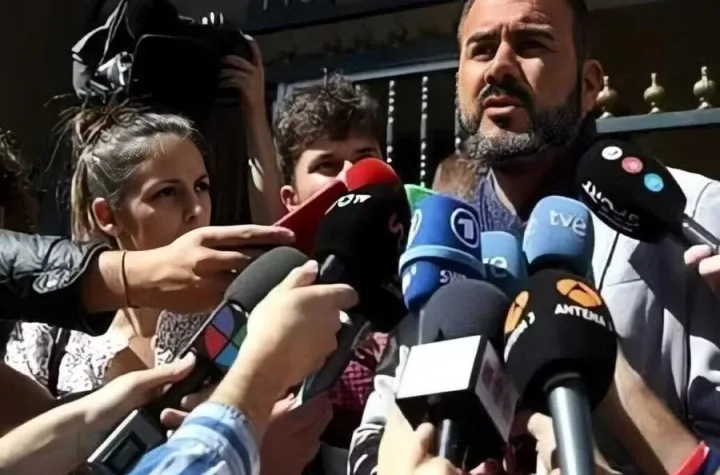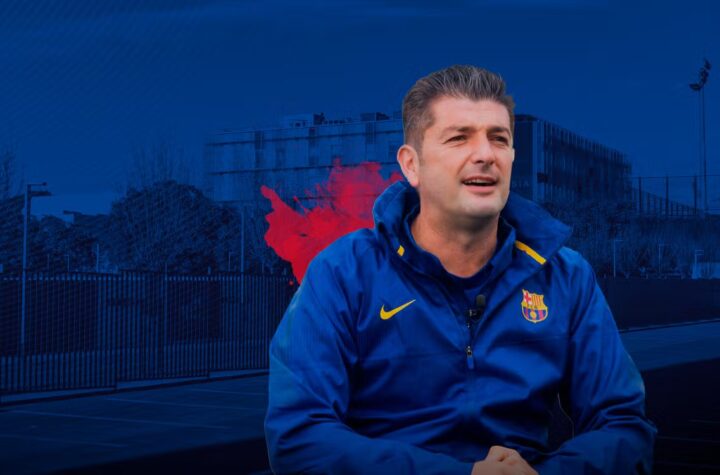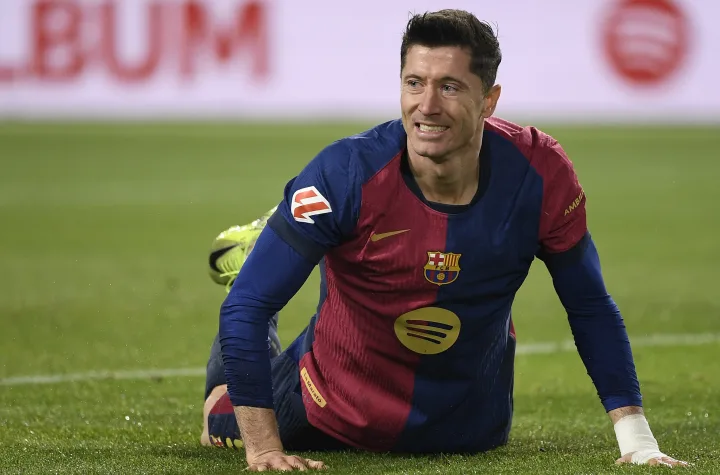
By Bharath Sangali
Real Sociedad vs FC Barcelona|1-0

Is the Anoeta curse back again? Last season, FC Barcelona escaped Anoeta with a very fortunate (some would say undeserved) 1-0 win. This year, La Real came into this game with a very clear match plan aimed at exposing the team’s flaws, and they executed it to a tee.
Right. Its panic time once again. Well, not really, but we know how the moods of big club fanbases swing from match to match. One game, we’re talking about the most fearsome team in Europe, the highest goalscoring team in the top 5 leagues, the team which beat Bayern Munich and Real Madrid in the same week; the next game, it’s a mentally fragile team who let the fans down when they need to step up. The truth, as usual, is somewhere in between
So, the most noticeable change in the lineup was the absence of Lamine Yamal, who I think has easily been Barca’s best player this season (Pau Cubarsi and Pedri complete the top 3). And his absence was noticeable from the get-go. This team’s attacking structure is highly dependent on Lamine, and that couldn’t have been more evident from the performances of Lewandowski and Raphinha this game. Allow me to summarize it in bullet points.
- No Lamine, no dribbling ability on the wings, nor anyone who can remotely match his game IQ and passing. Fermin, for all his abilities, is best known for his ability to attack depth, along with his goalscoring instincts in the final third. However, he’s not exactly a touchline winger, is he?
- This forces Kounde to take on a much larger proportion of the attacking responsibility. Now Kounde is fine when his job is to give Lamine the ball and adjust to his movements (he does this pretty well actually), but when he is tasked with bearing more of a creative burden, he will invariably fall short. Again, he isn’t to blame here, seeing as his natural position is that of a CB. (No, I don’t expect a Dani Alves level of output from a converted RB).
- Raphinha’s value as an off-ball runner is greatly diminished. When two of your other frontline partners aren’t really known for their creativity and dribbling, that’s sort of what he needed to offer here. Not really his forte. Also, we absolutely cannot ask Raphinha to hold width (I’ll explain later)
- Lewa is neutered massively without Raphinha’s off ball movement (used in conjunction with Lamine’s gravity and passing). He’s not a self-sufficient striker at this stage in his career, and you aren’t playing to his strengths playing in this manner.
Anyway, let’s get to the actual game and break things down.
Passmaps:
FC Barcelona

Ok, so a couple of thoughts from this pass map:
- It’s evident from this that the left flank was non-existent. Raphinha is ahead of Lewa. (He’s done this in every game this season, and rightfully so, but with Lamine’s absence, his role as a runner would have to be balanced with more creative responsibilities. Balde, for all his qualities, is not exactly the smartest player in the final third.
- Barely any central combinations (compared to previous games this season)
Real Sociedad:

- Look at how crucial Kubo is. All the progression happens through him.
- Barely any central combinations here as well, but unlike in Barca’s case, this is more by design. I’ll explain down the line.

Figure 1: Kubo had a great game
Ok , so what was Barca’s plan in attack? Well, based on the lineup, I’m going to say that they wanted to control buildup with Frenkie and Casado in a double pivot, giving them security on the ball, a low fullbacks to draw the press in, and two wingers coming in central (Fermin and Raphinha). The pass map and average positions indicate as much, with Lewa dropping back into midfield while the two wingers (in theory) go central and make runs in behind. Look at the heatmaps of the fullbacks and the frontline to see this

Figure 2: Heatmaps of the fullbacks and the frontline

Figure 3: Low fbs, double pivot of Frenkie and Casado

Figure 4: Lewa drops a little deeper, Barca attack with a front 4 when Pedri pushes up
So, why didn’t this work?
Sociedad went man for man in a high press. The keeper (Inaki Pena) was given a certain degree of time on the ball, taking advantage of the fact that he’s not exactly the best ball playing keeper out there. In fact, there’s this telling statistic which says that out of the 42 times that Barca tried to build up with the goalkeeper, they only reached the opposition half 13 times.
The press was designed as follows (Look at figure 4 below):
- Kubo and Oyarzabal (the wingers) cover the CBs.
- Becker on Kounde, while Casad and Frenkie were covered by Brais and Sucic

Figure 5: Sociedad’s man to man press, leaving the keeper free
Also, something to note here was that Sociedad’s defensive line was at 48.4m, which was even higher than Barca’s. They suffocated Barca higher up the pitch whenever they could, not allowing the players to turn and play the ball in behind.

Figure 6: Key match stats
The only goal of the game actually came from a situation where Inaki Pena has the ball, tries to play it long to Lewa, who looses the header. The ball breaks in the air to Sucic, who wins the header against Casado (he’s got a 6-inch advantage on Casado, absolutely not Casado’s fault). Becker, who’s been covering Kounde, then gets on the edge of it to slot it past the keeper.
Great example of a plan coming to fruition perfectly for Sociedad. Full credit to them for seeing an obvious weakness in the Barca buildup. Its easy to write these out purely from one team’s perspective, but the team doesn’t play in a vacuum, there’s some good, high-level competition out there.

Figure 7: The leadup to the only goal of the game
It’s fashionable to criticize Frenkie at the moment, easy to pin the blame on him for a bunch of other shortcomings. While Frenkie isn’t perfect by any means, to pretend like he’s essentially a liability holding back the team is a bit of a stretch.
Frenkie is coming back from being out for months, having only played a full game once before this, where he did perfectly ok (nothing spectacular). Before that, he had a great half against Madrid (a poor one, to be honest). In this game, the only time Barca had some degree of control on the game was before Frenkie had the knock which had him subbed off. It was his ability to receive the ball from the CBs and run into midfield that led to any of the team’s chances in the first half. While he could definitely be more influential in the final third, he was the only thing preventing us from going long for a large portion of the half. I see people criticizing him for missing that pass to Kounde on the run (see below). Granted, not the best execution, but the idea was right, and it wasn’t a horrible pass either. All the other players missed far simpler passes during the game.

Figure 8: Frenkie’s pass to Kounde
Once Frenkie had the knock, and consequentially had less of an impact on the game, the team’s frailties in buildup were more exposed. The fullbacks aren’t the best at receiving under pressure and advancing, and they kept a very low position on the pitch, forcing the keeper to go long on numerous occasions (Of course, Pena could have played out the back better, but that isn’t his forte).
The team tried to go direct toward Lewa on numerous occasions. However, this resulted in a direct, broken game, with Barca having no control. This is a game state that doesn’t suit this team, specially in the absence of Lamine. It definitely feels like this team needs to have more patterns of buildup, more relaxed ways of progression. This is harder to do with a Kounde that is sans Lamine though (he only works with Lamine on that side of the pitch at the moment), along with a Raphinha that looks to break in behind far more often than holding width and stretching the opposition’s backline. Flick definitely has some work to do here, there is a clear need to coach some better patterns of play to compensate for the loss of Lamine’s talent.
Some examples of quite poor/underwhelming buildup.

Figure 9: Horrible decision by the keeper to go long here.

Figure 10: The play continues

Figure 11: More examples
So how did Sociedad want to attack?

Figure 12: How Sociedad attacked
So, if anyone’s seen this Barca play this season, they know that the space to attack is in behind the fullbacks. The two pivots go narrow to protect the centre of the pitch, while the fullbacks are tracking back from higher up in transition. Bayern exploited this setup very well for stretches of the first half in their game. Here, Sociedad did something very similar.
Look at that pass map. Very few central combinations, but loads on Kubo’s side. The idea was to progress on that side, draw the defensive line across, and then overload to isolate (hello Dembele under Xavi).

Figure 13: Switch from the left wing to the other, Barca’s backline scrambles across to cover
If there’s one sequence that defined Barca’s lack of threat on the right wing, its this. I’mma let the pictures to do the talking.




Also, Raphinha is quite toothless on the left wing in Lamine’s role. He does not have the ability to dribble and drive inwards well enough from that angle, nor can he lead the buildup like Lamine. He can only really be used on the RW in his current role of someone who makes plenty of off ball runs to disrupt the opposition’s backline (which he can do excellently). So, when he vacates the wing to come central, if he cannot offer creativity in tight spaces, he’s easily nullified if he’s unable to offer a threat in behind.
Take a look at this sequence here:

Figure 14″ Raphinha cuts in to switch play

Figure 15: The play continues, ball breaks to Kubo

Figure 16: FBs caught high up the pitch in a very avoidable transition
Look at these stats, they’re indicative of his shortcomings. When a winger is fouled zero times, but fails to create any danger on the ball……

Pair that with Kounde, and you have a dead left wing as well. So basically, dead wings, being forced into a game of long balls and transitions, Sociedad executing their plan brilliantly, all of these came together to hand Barca their second league loss of the season.





More articles
Clash of Titans: FC Barcelona Femení faces Chelsea FCW again in the Champions League.
Miguel Galán: “Tebas actions with Barça have bad faith bordering on an alleged crime of administrative prevarication”
Franc Artiga: “They’re hiring me because I’ve been at Barça for many years”